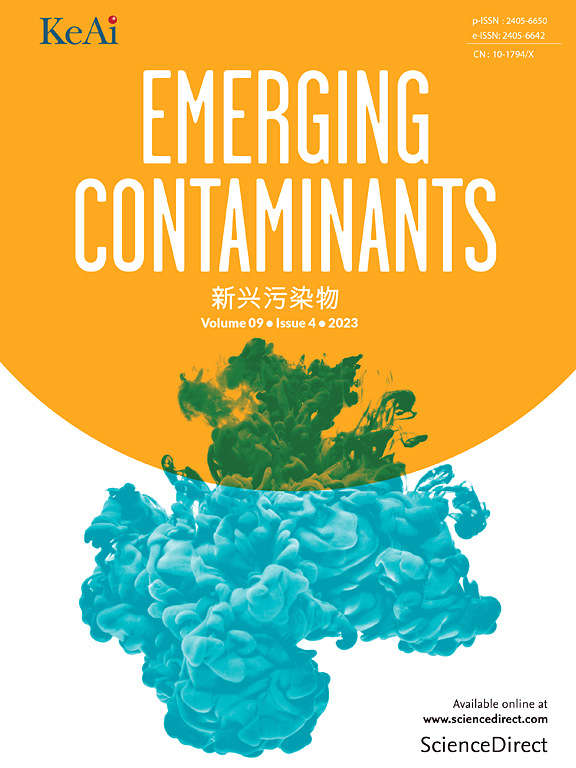Emerging contaminant removal using eco-friendly zinc ferrite nanoparticles: Sunlight-driven degradation of tetracycline
IF 6.9
2区 环境科学与生态学
Q1 ENVIRONMENTAL SCIENCES
引用次数: 0
Abstract
Emerging contaminants, particularly pharmaceutical pollutants, pose significant environmental challenges, necessitating sustainable remediation strategies. In this study, mesoporous zinc ferrite nanoparticles (ZnFe2O4) were synthesized via a green hydrothermal method using sweet cherry leaf extract for the photocatalytic degradation of tetracycline (TC) under natural sunlight. XRD analysis confirmed a spinel cubic structure with an average crystallite size of 8.02 nm, while XPS revealed the elemental composition, including Zn (8.92 %), Fe (17.6 %), C (27.88 %), and O (45.6 %). The nanoparticles exhibited a band gap of 4.87 eV, broad UV–visible absorption, and a specific surface area of 77.99 m2/g with a mean pore size of 10.79 nm, all contributing to enhanced photocatalytic activity. VSM analysis demonstrated superparamagnetic behavior with a saturation magnetization of 10.91 emu/g, which remained stable after photocatalysis (10.81 emu/g), indicating excellent structural stability and reusability. The degradation of TC followed a first-order kinetic model, achieving 94 % efficiency in the first cycle, with the rate constant decreasing from 0.0172 min⁻1 at 10 mg/L to 0.0043 min⁻1 at 50 mg/L. Even after five cycles, the material retained over 73 % degradation efficiency, showcasing its durability. This work highlights the potential of eco-friendly ZnFe2O4 nanoparticles as a sustainable and efficient solution for mitigating emerging contaminants in wastewater, contributing to environmental remediation efforts.

利用环保铁酸锌纳米颗粒去除污染物:阳光驱动四环素降解
新出现的污染物,特别是药物污染物,构成了重大的环境挑战,需要可持续的修复策略。本研究以甜樱桃叶提取物为原料,采用绿色水热法合成介孔铁酸锌纳米颗粒(ZnFe2O4),用于自然光照下光催化降解四环素(TC)。XRD分析证实其为尖晶石立方结构,平均晶粒尺寸为8.02 nm, XPS分析显示其元素组成为Zn(8.92%)、Fe(17.6%)、C(27.88%)和O(45.6%)。该纳米颗粒的带隙为4.87 eV,具有较宽的紫外可见吸收,比表面积为77.99 m2/g,平均孔径为10.79 nm,具有较强的光催化活性。VSM分析显示其超顺磁性,饱和磁化强度为10.91 emu/g,光催化后保持稳定(10.81 emu/g),具有良好的结构稳定性和可重复使用性。TC的降解遵循一级动力学模型,在第一个循环中达到94%的效率,速率常数从0.0172分钟(10 mg/L)下降到0.0043分钟(50 mg/L)。即使经过五次循环,该材料仍保持超过73%的降解效率,显示出其耐久性。这项工作强调了环保型ZnFe2O4纳米颗粒作为一种可持续和有效的解决方案的潜力,可以减轻废水中新出现的污染物,有助于环境修复工作。
本文章由计算机程序翻译,如有差异,请以英文原文为准。
求助全文
约1分钟内获得全文
求助全文
来源期刊

Emerging Contaminants
Medicine-Public Health, Environmental and Occupational Health
CiteScore
10.00
自引率
6.70%
发文量
35
审稿时长
44 days
期刊介绍:
Emerging Contaminants is an outlet for world-leading research addressing problems associated with environmental contamination caused by emerging contaminants and their solutions. Emerging contaminants are defined as chemicals that are not currently (or have been only recently) regulated and about which there exist concerns regarding their impact on human or ecological health. Examples of emerging contaminants include disinfection by-products, pharmaceutical and personal care products, persistent organic chemicals, and mercury etc. as well as their degradation products. We encourage papers addressing science that facilitates greater understanding of the nature, extent, and impacts of the presence of emerging contaminants in the environment; technology that exploits original principles to reduce and control their environmental presence; as well as the development, implementation and efficacy of national and international policies to protect human health and the environment from emerging contaminants.
 求助内容:
求助内容: 应助结果提醒方式:
应助结果提醒方式:


